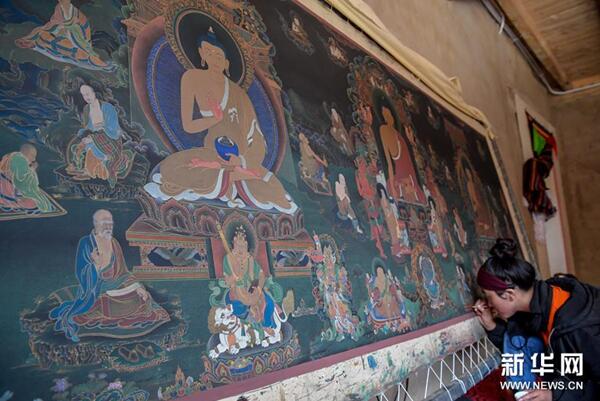Regong Thangka paintings debut at Beijing's 798 Art Zone
- By Xu Xiaoxuan
 0 Comment(s)
0 Comment(s) Print
Print E-mail China.org.cn, October 10, 2020
E-mail China.org.cn, October 10, 2020

The exhibition of Regong Thangka paintings made its debut at 798 Art Zone in Beijing on October 1. Nearly 100 exquisite Thangka works are being displayed, presenting the enthralling Tibetan art and culture nurtured at the source of the Yellow River.
Among the exhibits, the 38-meter-long scroll "The Five Hundred Arhats," created by more than 20 Thangka painters over a period of four years, has caught the eye of many Chinese and foreign visitors.
The painters first painted on six cloth pieces and then put them together to make the scroll. The five hundred lifelike Arhats depicted in the painting have various gestures and poses.
"We have been practicing Thangka art for generations," said Tashi, one of the painters from the birthplace of Regong arts—Huangnan Tibetan Autonomous Prefecture, northwest China's Qinghai province, "The creation of the scroll 'The Five Hundred Arhats' was started in 2004 and finished in 2007. I hope to pass on the Regong arts, and this is also part of the effort to protect traditional Chinese art and culture."
Regong arts is a crucial part of Tibetan Buddhist art in China and was inscribed in 2009 on the UNESCO Representative List of the Intangible Cultural Heritage of Humanity. This school of art includes Thangka and mural paintings, Barbola and patchwork crafts, and sculpting. The themes include fairy tales and epic stories in Tibetan Buddhism, traditional Tibetan medicine, astronomy, geography, etc.
Thangka is the art of painting religious scrolls used to venerate the Buddha. A special brush is used to apply natural dyes to cloth prepared with patterns sketched in charcoal. Thanks to the natural dyes, Thangka paintings can retain their color intensity even after hundreds of years.
The exhibition will run through Nov. 2. During the exhibition, an on-the-spot auction will be held, and all proceeds will be donated to social welfare undertakings.






Go to Forum >>0 Comment(s)